How to fish the Cottage Pool on the Welsh Dee at Llangollen
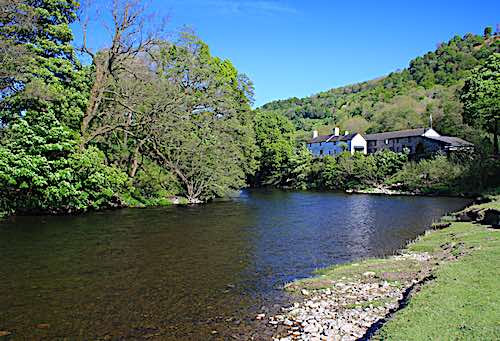
Cottage Pool Introduction
I’ve produced this fly fishing guide to share my knowledge on how to fish the Cottage Pool.
It’s a lovely pool for fly fishing and is easy to wade and fish from the right bank. As a bonus, it’s a great place for beginners to practice casting.
The Cottage Pool holds a good head of trout and grayling. In addition, salmon and sea trout are caught in this pool but mainly on the spinner.
Fly Fishing for trout and grayling:
The Cottage Pool has been formed as the river is diverted easterly by the high right bank. This has produced a deep hole close to the steep right bank. Therefore, it is only to fish the riffle and the top section of the pool from the right bank.
On sunny days, it’s best to fish the pool first thing in the morning or the evening because the sun is behind you from mid-morning to late afternoon. Making it difficult to avoid spooking the fish.
The Cottage Pool can be fished at river levels from its summer level to about 1m (Manley Hall gauge). However, I have the most success trout and grayling fishing when the river level has been between 0.5 and 0.65m.
Fishing the Cottage Pool in low water
When the Welsh Dee is close to its summer level, trout and grayling often lie in the places I have highlighted on the following sketch of the Cottage Pool.
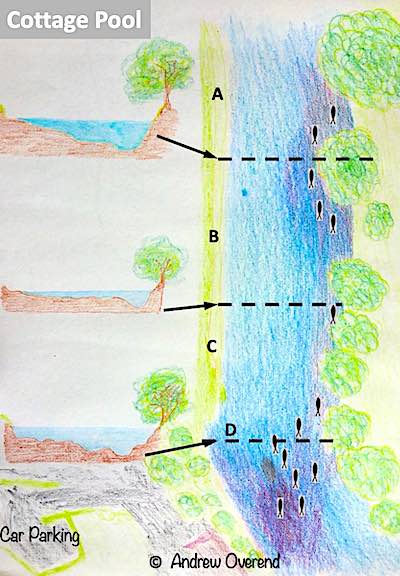
Point C on the sketch marks the head of the main pool, where I wade out and fish down to point D when the river is less than 0.6m (Manley Hall gauge).
The riverbed is composed of a mix of large pebbles and small boulders, which can be slippy when the river has been low for a while.
On fishing to point D the river gets gradually deeper to a large submerged boulder, passed which it’s too deep to wade.
There are a couple of fish trout holding spots close to the far bank from point C to A. Especially in the deeper water opposite position A,
There are a number of approaches that can be taken to fish the Cottage Pool. However, for this guide, I’ve chosen those that are helpful to someone who hasn’t fished this pool before.
Fishing the head of the pool (point C):
On walking down from the car park you’ll reach the head of the pool (point C). When the river is running clear and close to its summer level I normally fish down to point D with the wet flies.
Initially, fish as much of the water without wading to avoid spooking the the fish feeding mid-river.
If I’m getting offers on the wet flies then I will return to point C and wade out and cover the water close to the far bank with the wet fly.

Fishing the riffle (point C to A):
After fishing the head of the Cottage Pool, I fish up through the riffle to point (A). This is a great place to search for rising trout and grayling with the dry fly.
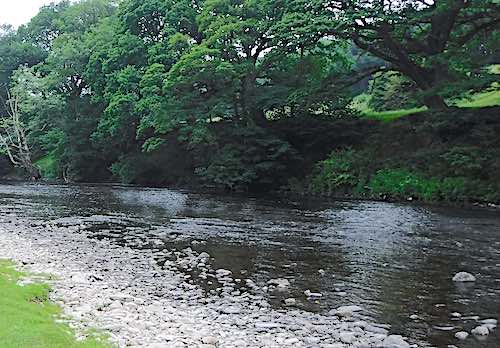
In the riffle fish lie in the deep pockets of water close to the shelter of the overhanging trees on the far bank.
If fish aren’t rising try fishing a nymph suspended under a dry fly (Klink & DInk).
My final approach is to fish down from point (A) by casting a team of wet flies and/or spiders across to the far banks, let the dead drift and then allow them to swing round to the dangle.
Fishing the Cottage Pool in high water:
When the Welsh Dee river level is between 0.7 and 1m (Manley Hall gauge) only fish the Cottage pool from the bank. Starting from just above point C and fishing down to point E,
If the river is running clear I find it best to fish the pool with a team of wet flies or nymphs. Casting them across the river and allowing them to swing around to the dangle. In high water trout and grayling move into the margins where the flow is slacker.
In coloured water, when all else had failed, fishing a streamer (e.g. size 10 to 8 Wooly bugger pattern) on a sink-tip line tipped with 4ft of 7lb fluorocarbon is definitively worth a try. I’ve lost count of the number of times….
fishing a streamer has staved the day
How does my approach changes with the season?
Spring fishing tips for trout:
The brown trout fishing season on the Welsh Dee starts on the 3rd March. However, the weather in March is often more like winter than spring.
If it has been a wet winter the river is often high (> 0.7m Manley Hall gauge) and your limited to fishing the head of the Cottage Pool.
On mild days, hatches of large dark olives and March Browns usually start around 11 am and you will often spot trout picking them off as they drift through this pool. During these hatches, my approach is to target the rising fish with the dry fly (large dark olive or March Brown pattern).
Alternatively, fishing a team wet flies on a floating line often yields some beautiful over-wintered brown trout. The following is one of my default team of wet flies/spiders.

If either of the above fails, I will try my luck fishing the pool with a couple of nymphs suspended under a sight fly (Klink & Dink method).
Information on the fly selection for March is discussed in the following article…
Brown trout fishing in April…
In April, the weather usually warms, and hatches of Large Dark Olives, March Brown, and Grammon become more prevalent from mid-morning to mid-afternoon.
Information on the fly selection for the Welsh Dee in April is discussed in the following article…
Fly fishing in May:
Fly hatches become prolific as the weather warms and dries during May, and brown trout become eager to fatten up on the emerging fly life. Examples of flies you will see include:
Sedges:
- Black sedge
- Grannaom
- Cinnamon sedge
- Medium sedge
Others
- Hawthorne fly
- Alderfly
- Large stonefly
- Midges
As a result of all the fly-life, May is when dry fly fishing and upstream wet-fly fishing produce the best results once you have identified which flies the trout are taking.
On overcast days, the fishing can be good from morning to dusk.
Whereas, on sunny days, the fishing dies between 11 am and 5 pm because there is a lack of shade on this pool, and the sun is behind you.
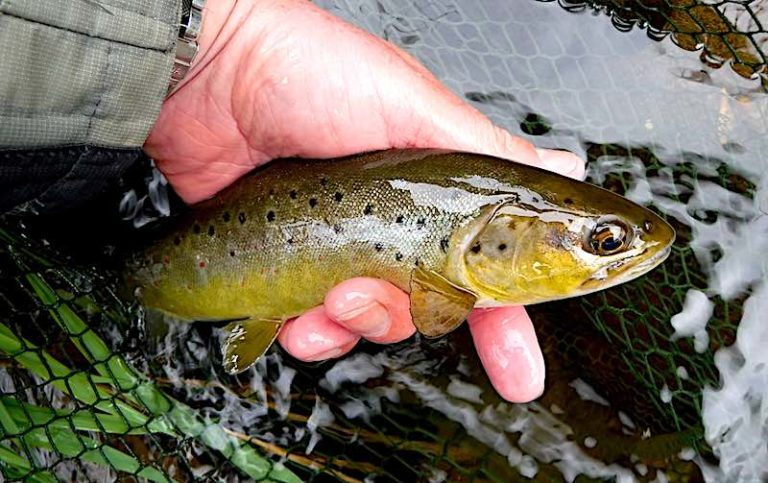
Summer fishing tips:
When the river is low during the summer months, fast, oxygenated water at the head of the Cottage Pool is a good place to fish. On sunny days, the best fishing is early in the morning and after 5 pm.
More information on the fly selection for summer is covered in the following posts.
Autumn fishing tips:
In October, my attention turns to grayling fly fishing until spring on the Welsh Dee.
River conditions govern my grayling fishing in autumn and winter, and I only fish the Cottage Pool when the river is running clear and below 0.7m (Manley Hall gauge).
During October on the Welsh Dee, fly hatches are still common on most days. The flies you are likely to see hatching include:
- Iron Blue Dun
- Pale Watery Dun
- Olive Upright
- Egg-laying Stoneflies
- Midges
My approach to fly fishing the Cottage Pool depends on the river height, water, and weather conditions.
In October, mornings are often cool, and fly hatches don’t usually start until mid-morning.
Before 10 am, I begin fishing this pool from the bank with a team of wet flies. The flies are cast towards the far bank and allowed to swing around to the dangle.
My default wet fly recommendation is the following team of three flies cast on 3lb copolymer (point: March Brown spider #14; middle dropper: black hopper #14; top dropper: claret spider #16).
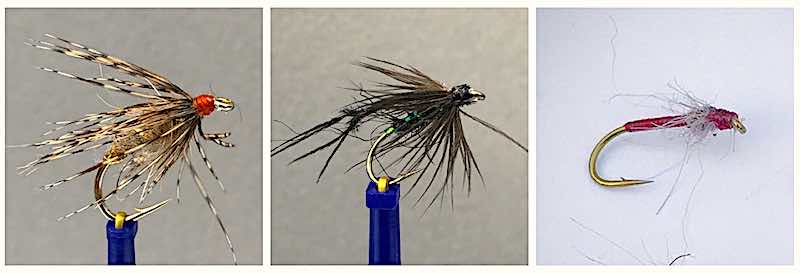
Once flies are observed hatching, I switch to targeting rising grayling with the dry fly. Ideally, it’s best to try and identify the flies that are being taken and tie on a suitable imitation.
If that is not possible, I begin with a CDC olive emerger pattern that has served me well. If that fails, I start working through my fly box. However, it’s rare not to catch a grayling on one of the three following patterns:
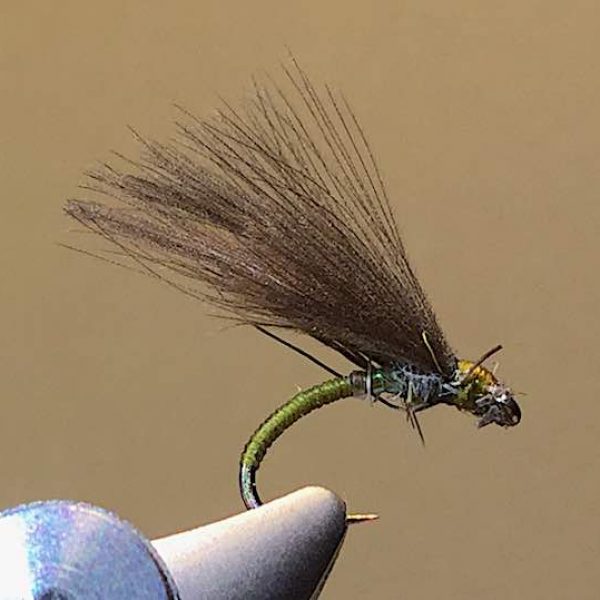
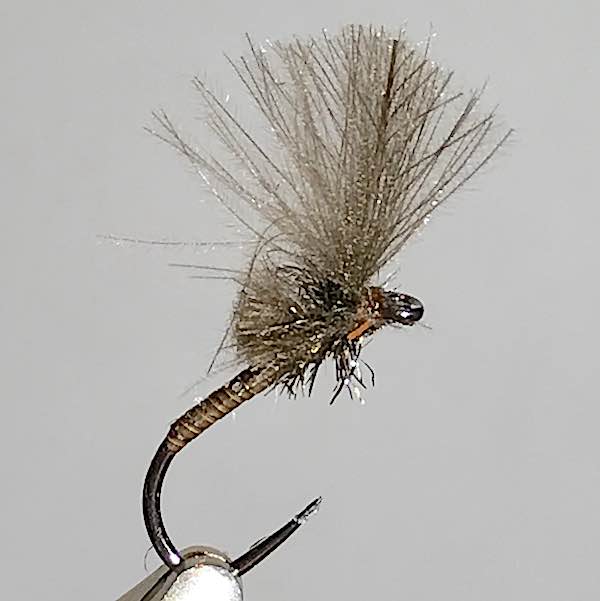

On rare occasions, it’s not possible to tempt grayling with either of the above approaches. Then, I switch to fishing nymphs close to the riverbed.
October’s fly selection is discussed in the following post.
Fly fishing in November:
The clocks go back at the end of October, and the days get increasingly shorter during November.
With aquatic life becoming dormant for winter, fly hatches are sparse, and grayling are increasingly searching the riverbed for food: nymphs, larvae, worms, etc.
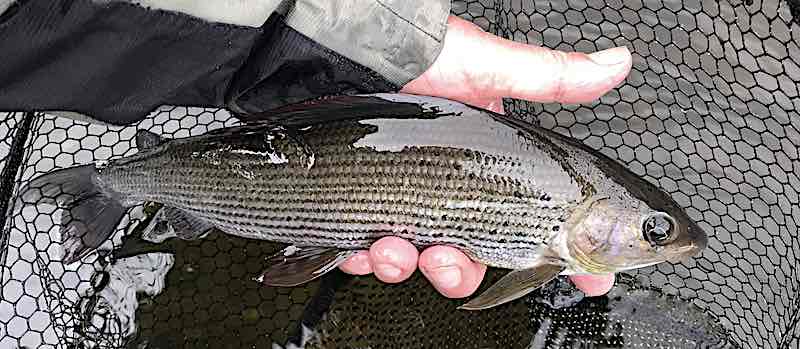
The clocks go back at the end of October, and the days get increasingly shorter during November.
With aquatic life becoming dormant for winter, fly hatches are sparse, and grayling are increasingly searching the riverbed for food: nymphs, larvae, worms, etc.
Fishing for grayling during November can be great because they have to feed hard to ensure they are in peak condition for spawning in spring.
Good results can be achieved fishing a team of nymphs under a bung on November mornings.
On mild days, sporadic hatches of olives usually occur around lunchtime. If this happens, then switching to fishing dry or wet flies often is the best approach.
Information on fly selection for November is covered in the following post.
Winter grayling fishing:
Once winter sets in, the Welsh Dee is more often than not in flood during the winter months and the opportunities to fish the Cottage Pool diminish.
If the river level is below 0.7m (Manley Hall gauge) it is, however. worth fishing for grayling because they start to shoal in the pool before spawning in the spring.
My approach to fishing this pool during the winter months is very similar to that used in November.
For more information on the flies to use on the Welsh Dee during winter check out the following articles:
Fly fishing for sea trout:
During July the pools near Llangollen become to be populated with sea trout and a few rest up in the Cottage Pool during their journey upriver.
I rarely fish the Cottage Pool for sea trout after dark because the Cottage on the high bank has a powerful outdoor light that shines onto the pool. However, I do fish the pool for sea tout duing the last couple of daylight using small wet flies for the last hour of daylight.

When fishing with a light line, it’s wise to let the fish take off once hooked until you know what you’re dealing with; a big grayling, brown trout, or sea trout.
I’ve only caught small sea trout (ca. < 2 lbs) from the Cottage Pool, but they provide great sport.
Check out the following post for more on…
Fly fishing for Salmon:
Most years, I’ve seen the odd salmon jumping in the Cottage Pool but they are not easy to catch on the fly.
To help you with where to focus your salmon fishing activities in the Cottage pool I have produced the following sketch show where the typically jump.

I have had a few salmon take the fly but not managed to land one there yet but I was privileged to take the follow picture of a salmon my friend caught at the head of the cottage pool on the golden Willie Gun tube fly.
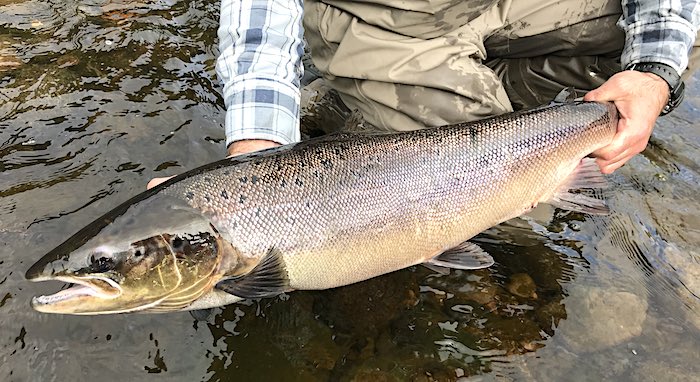
From September onwards I start salmon fishing at the head of the pool (point C) with fly from when the river level is above 0.6m (Manley Hall gauge). Using either use a floating line with a 12ft copolymer tapered leader (12lb tip) or a sink-tip line when the river is slightly coloured.For fly selection, I normally follow this simple approach
Stoats tail
In coloured water a size 10 or higher brightly coloured fly (e.g. Cascade, Park shrimp etc).
Where do I get day tickets?
Day tickets to fish the Cottage Pool are obtained from the Llangollen-Maelor website (Tariffs).
Please contact the club for additional advice on fishing the Welsh Dee at Llangollen, they will be happy to help you.
How to get to the Cottage Pool:
Access to Ddol-Isaf is via the A5 between Forncysyllte and Llangollen Golf Club (see map). Take a tag from the sign-in box on the gate and follow the track down to the farm. Parking is limited to the marked area before the farm (see club rules).
To get to the Cottage pool, walk down the lane 20m towards the Cottages, go through the gate on your left, walk down the side of the barn and into the field, and then follow the fence on your right to the Cottage Pool.
Fishing, like most outdoor sports, is not without its hazards. Therefore, YOU MUST DO YOUR OWN RISK ASSESSMENT before starting to fish. Especially if you decide to wade and/or fish at night. In addition, you must follow the Llangollen-Maelor Club Rules when accessing and fishing this water.